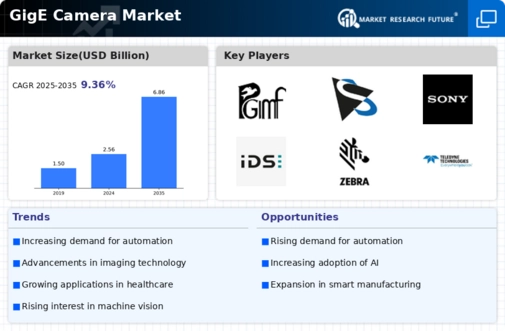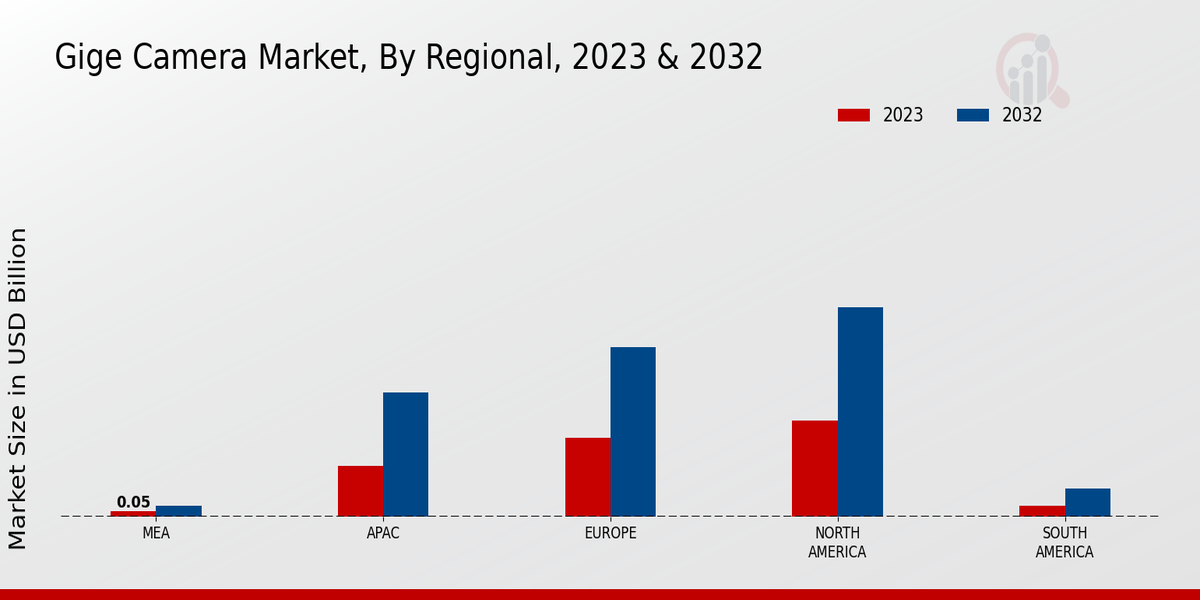Market Growth Projections
The Global GigE Camera Market Industry is poised for substantial growth, with projections indicating a market size of 6.86 USD Billion by 2035. This growth trajectory is supported by a compound annual growth rate (CAGR) of 9.37% from 2025 to 2035. The increasing adoption of GigE cameras across various sectors, including manufacturing, healthcare, and automation, suggests a robust demand for high-performance imaging solutions. The market's expansion is likely to be fueled by technological advancements and the growing emphasis on quality control and automation, indicating a promising future for the industry.
Technological Advancements
The Global GigE Camera Market Industry is experiencing rapid technological advancements that enhance camera performance and functionality. Innovations in sensor technology, image processing algorithms, and connectivity options are driving demand. For instance, the integration of advanced CMOS sensors allows for higher resolution and faster frame rates, appealing to industries such as manufacturing and healthcare. As a result, the market is projected to reach 2.56 USD Billion in 2024, reflecting a growing reliance on high-quality imaging solutions. These advancements not only improve image quality but also expand the applications of GigE cameras in various sectors, indicating a robust growth trajectory.
Growing Adoption in Healthcare
The healthcare sector is increasingly adopting GigE cameras for various applications, including surgical imaging, diagnostics, and telemedicine. The Global GigE Camera Market Industry is benefiting from this trend as hospitals and clinics seek high-quality imaging solutions to enhance patient care. The ability to capture detailed images in real-time is crucial for accurate diagnostics and treatment planning. As the market evolves, it is projected to reach 2.56 USD Billion in 2024, driven by the demand for advanced imaging technologies in healthcare. This growing adoption not only improves patient outcomes but also supports the overall advancement of medical technology.
Rising Demand for Quality Control
Quality control is becoming increasingly critical in manufacturing and production processes, driving the Global GigE Camera Market Industry. Companies are investing in high-resolution imaging systems to ensure product quality and compliance with industry standards. GigE cameras offer superior image quality and speed, making them ideal for real-time inspection and monitoring. This trend is evident as the market is anticipated to reach 6.86 USD Billion by 2035, reflecting the growing emphasis on quality assurance. The ability to detect defects early in the production process can lead to significant cost savings and improved customer satisfaction, further propelling market growth.
Increasing Automation in Industries
The Global GigE Camera Market Industry is significantly influenced by the increasing automation across various sectors. Industries such as manufacturing, automotive, and pharmaceuticals are adopting automated systems that require high-resolution imaging for quality control and monitoring. The demand for GigE cameras is likely to surge as these industries seek to enhance operational efficiency and reduce human error. With the market projected to grow at a CAGR of 9.37% from 2025 to 2035, the integration of GigE cameras into automated processes is expected to play a crucial role in achieving higher productivity and precision.
Expansion of Machine Vision Applications
The expansion of machine vision applications is a key driver for the Global GigE Camera Market Industry. As industries increasingly adopt machine vision systems for automation, inspection, and measurement, the demand for high-performance cameras is rising. GigE cameras are particularly suited for these applications due to their high-speed data transfer capabilities and compatibility with various software platforms. This trend indicates a robust market potential, with projections suggesting a CAGR of 9.37% from 2025 to 2035. The versatility of GigE cameras in diverse applications, from robotics to quality assurance, positions them as essential components in modern industrial processes.

























Leave a Comment